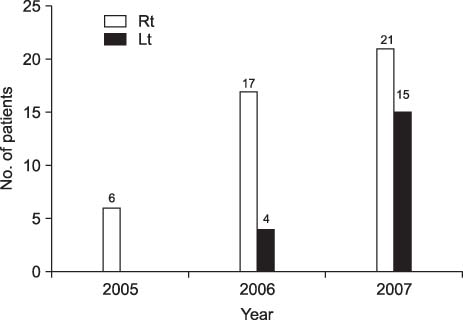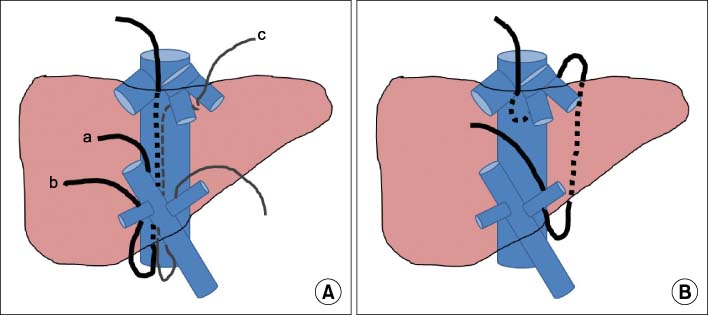J Korean Surg Soc.
2010 Aug;79(2):122-129. 10.4174/jkss.2010.79.2.122.
Clinical Application of Hepatic Resection Using Glissonean Pedicle Transection Method and Hanging Maneuver
- Affiliations
-
- 1Division of Hepato-Biliary and Pancreas Surgery, Department of Surgery, Haeundae Paik Hospital, Inje University College of Medicine, Busan, Korea.
- 2Division of Hepato-Biliary and Pancreas Surgery, Department of Surgery, Asan Medical Center, University of Ulsan College of Medicine, Seoul, Korea. yjlee@amc.seoul.kr
- KMID: 2211982
- DOI: http://doi.org/10.4174/jkss.2010.79.2.122
Abstract
- PURPOSE
The liver hanging maneuver (LHM) is a useful technique enabling a safe anterior approach, which is one of the most important innovations in the field of major hepatic resections. This study was conducted to review tumors' profiles after applying this procedure and to evaluate the usefulness of LHM and Glissonean pedicle transaction method (GPTM).
METHODS
Medical records of 64 patients who underwent hepatic resection using LHM and GPTM at the Asan Medical Center were reviewed. The classic LHM was conducted according to the Belghiti method.
RESULTS
Among 64 patients, 46 patients had hepatocellular carcinoma; 7, intrahpatic cholangiocarcinoma; 4, hilar cholangiocarcinoma; 4, metastatic liver cancer; 3, benign liver tumor. Mean tumor size was 10.6 cm (3~22). Mean liver parenchymal transection time was 20 min (15~30). Right side hepatectomy was performed in 44 patients; left side hepatectomy with or without caudate lobe was performed in 19 patients. Twenty patients (31.3%) required blood transfusion during surgery. There was no in-hospital mortality or major complications. Minor complications developed in 6 patients (9.37%).
CONCLUSION
GPTM and LHM are a safe and useful surgical application of various anatomical resections for huge liver tumor and an effective procedure during left hepatectomy with or without caudate lobe.
Keyword
Figure
Reference
-
1. Yamamoto M, Takasaki K, Ohtsubo T, Katsuragawa H, Fukuda C, Katagiri S. Effectiveness of systematized hepatectomy with Glisson's pedicle transection at the hepatic hilus for small nodular hepatocellular carcinoma: retrospective analysis. Surgery. 2001. 130:443–448.2. Torzilli G, Leoni P, Gendarini A, Calliada F, Olivari N, Makuuchi M. Ultrasound-guided liver resections for hepatocellular carcinoma. Hepatogastroenterology. 2002. 49:21–27.3. Takasaki K. Glissonean pedicle transection method for hepatic resection: a new concept of liver segmentation. J Hepatobiliary Pancreat Surg. 1998. 5:286–291.4. Takasaki K. Hepatic resection using glissonean pedicle transection. Nippon Geka Gakkai Zasshi. 1998. 99:245–250.5. Lai EC, Fan ST, Lo CM, Chu KM, Liu CL. Anterior approach for difficult major right hepatectomy. World J Surg. 1996. 20:314–318.6. Liu CL, Fan ST, Cheung ST, Lo CM, Ng IO, Wong J. Anterior approach versus conventional approach right hepatic resection for large hepatocellular carcinoma: a prospective randomized controlled study. Ann Surg. 2006. 244:194–203.7. Liu CL, Fan ST, Lo CM, Tung-Ping Poon R, Wong J. Anterior approach for major right hepatic resection for large hepatocellular carcinoma. Ann Surg. 2000. 232:25–31.8. Belghiti J, Guevara OA, Noun R, Saldinger PF, Kianmanesh R. Liver hanging maneuver: a safe approach to right hepatectomy without liver mobilization. J Am Coll Surg. 2001. 193:109–111.9. Hwang S, Lee SG, Lee YJ, Kim KH, Ahn CS, Kim KW, et al. Modified liver hanging maneuver to facilitate left hepatectomy and caudate lobe resection for hilar bile duct cancer. J Gastrointest Surg. 2008. 12:1288–1292.10. Kim SH, Park SJ, Lee SA, Lee WJ, Park JW, Kim CM. Isolated caudate lobectomy using the hanging maneuver. Surgery. 2006. 139:847–850.11. Suh KS, Lee HJ, Kim SH, Kim SB, Lee KU. Hanging maneuver in left hepatectomy. Hepatogastroenterology. 2004. 51:1464–1466.12. Tanaka S, Taira K, Kudo A, Nakamura N, Ito K, Arii S. Anterior approach for left-sided hepatic resection. Hepatogastroenterology. 2008. 55:1760–1763.13. Nanashima A, Sumida Y, Abo T, Takeshita H, Hidaka S, Sawai T, et al. Trisectionectomy for large hepatocellular carcinoma using the liver hanging maneuver. Eur J Surg Oncol. 2009. 35:326–330.14. Hwang S, Lee SG, Ha TY, Ahn CS, Park KM, Kim KH, et al. Simplified standardized technique for living donor liver transplantation using left liver graft plus caudate lobe. Liver Transpl. 2004. 10:1398–1405.15. Takatsuki M, Kawashita Y, Eguchi S, Tajima Y, Kanematsu T. Tape-guided living donor left hepatectomy. Am J Surg. 2007. 194:107–109.16. Liddo G, Buc E, Nagarajan G, Hidaka M, Dokmak S, Belghiti J. The liver hanging manoeuvre. HPB (Oxford). 2009. 11:296–305.17. Nanashima A, Sumida Y, Abo T, Nagayasu T, Sawai T. Usefulness and application of the liver hanging maneuver for anatomical liver resections. World J Surg. 2008. 32:2070–2076.18. Ogata S, Belghiti J, Varma D, Sommacale D, Maeda A, Dondero F, et al. Two hundred liver hanging maneuvers for major hepatectomy: a single-center experience. Ann Surg. 2007. 245:31–35.19. Trotovsek B, Belghiti J, Gadzijev EM, Ravnik D, Hribernik M. Anatomical basis of the liver hanging maneuver. Hepatogastroenterology. 2005. 52:728–730.20. Tsuruta K, Okamoto A, Toi M, Saji H, Takahashi T. Impact of selective Glisson transection on survival of hepatocellular carcinoma. Hepatogastroenterology. 2002. 49:1607–1610.21. Kim SH, Park SJ, Lee SA, Lee WJ, Park JW, Hong EK, et al. Various liver resections using hanging maneuver by three glisson's pedicles and three hepatic veins. Ann Surg. 2007. 245:201–205.22. Hashikura Y, Kawasaki S. Living donor liver transplantation: issues regarding left liver grafts. HPB (Oxford). 2004. 6:99–105.
- Full Text Links
- Actions
-
Cited
- CITED
-
- Close
- Share
- Similar articles
-
- “Liver-loop”: A case report of an alternative modified liver hanging maneuver
- Application of temporary inflow control of the Glissonean pedicle method provides a safe and easy technique for totally laparoscopic hemihepatectomy by Glissonean approach
- Significance of liver hanging maneuver for anatomical hepatectomy in patients with a large hepatocellular carcinoma compressing intrahepatic vasculatures
- Changing patterna in the Serum Amylase Level and the Serum Lipase Level Following Hepatic Resection with Pringle's Maneuver
- Outcomes of Hepatic Resection Using Intermittent Hepatic Vascular Inflow Occlusion with Low Central Venous Pressure




